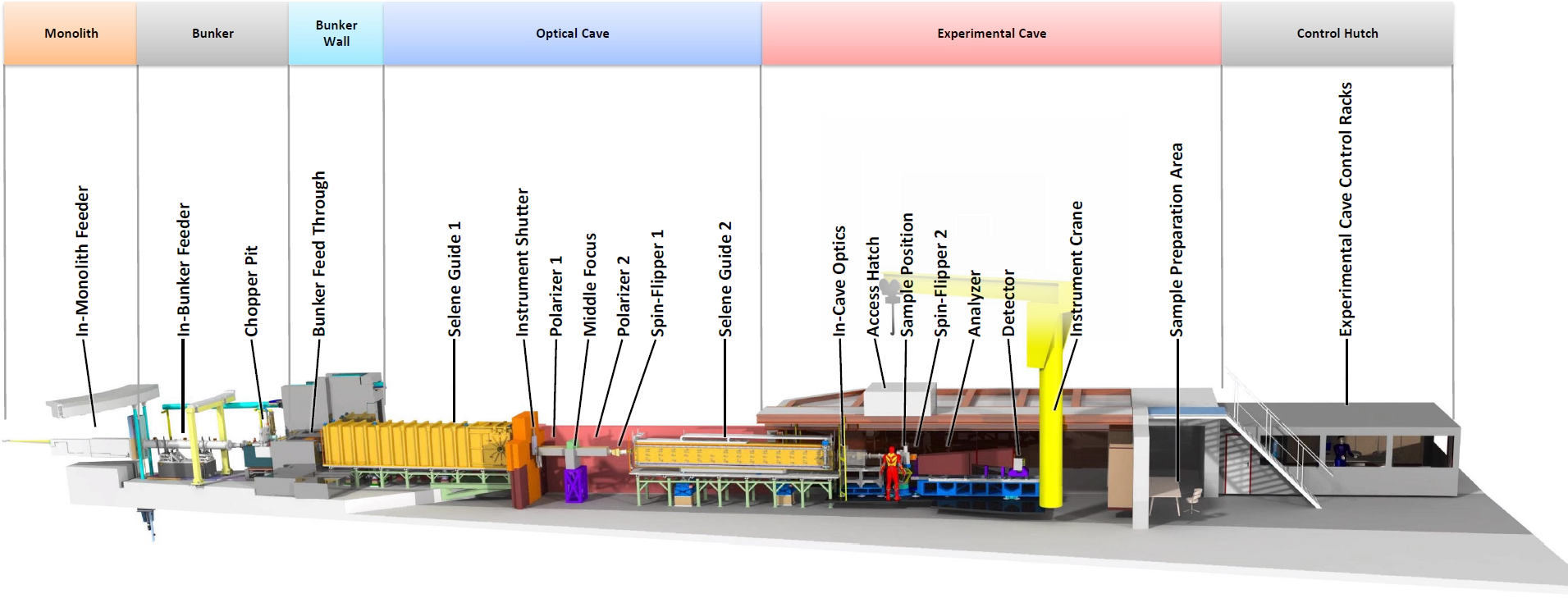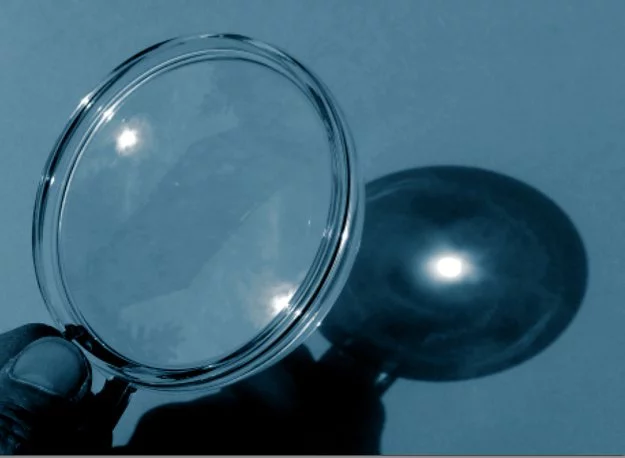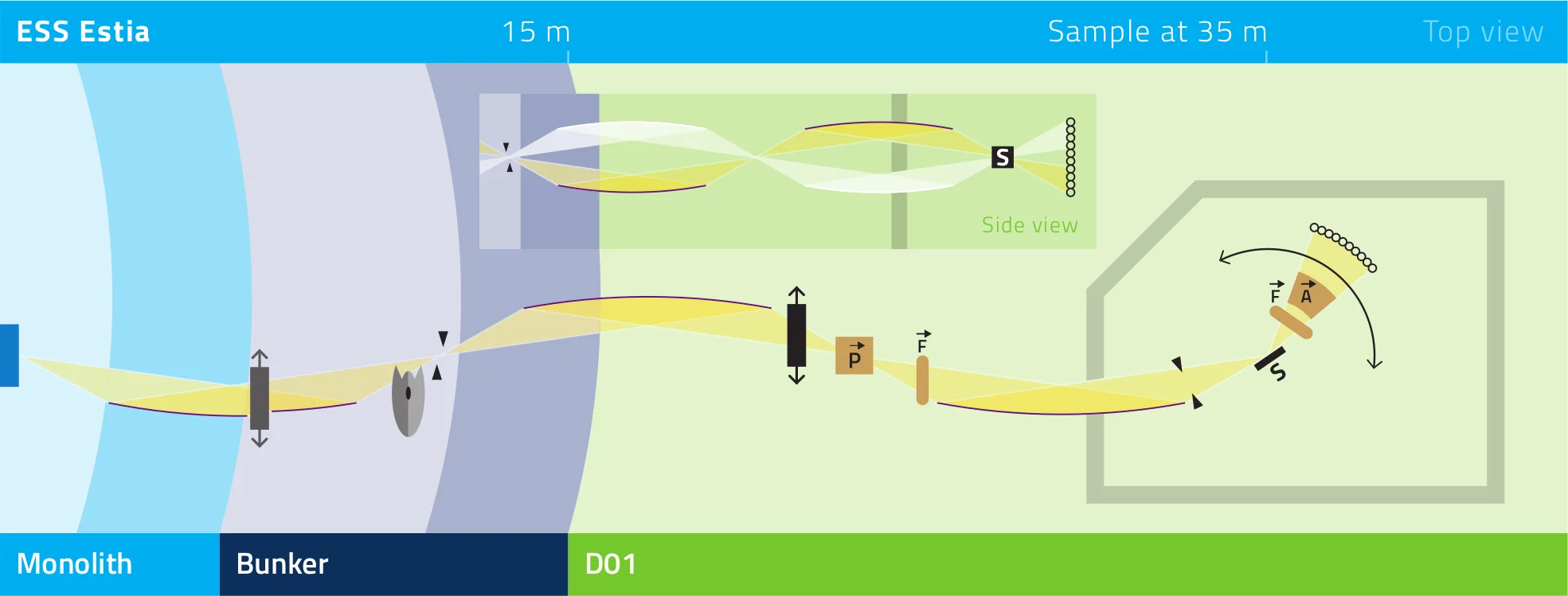Estia
Estia is one of the two initial reflectometers for the European Spallation Source ESS. It will have a horizontal scattering plane and is optimised for a small sample area and polarized measurements. Estia was developed by the Swiss-Danish Instrumentation Consortium under the lead of Jochen Stahn. Starting from summer 2015, after the acceptance of the instrument proposal as one of the initial 15 instrument of the ESS, the project is lead by PSI as Swiss in-kind contribution. The design effort is lead by the Estia lead scientist Artur Glavic and lead engineer Sven Schütz at PSI. (Animation: Take a flight through Estia)

Estia description

Estia will be the first reflectometer at the ESS, optimized for small magnetic samples and in-situ or in-operando studies. The complementary instrument Freia is optimized for studies on liquid/liquid or liquid/gas interfaces.
The special feature of Estia is the focusing of the neutron beam to the sample in both the scattering and the surface plane with a high divergence of 1.5 deg x 1.5 deg. This allows to choose between various operation modes, e.g. for high-intensity specular reflectivity, extended q-range high-resolution, or almost conventional measurements with a well collimated beam at a fixed angle. In all modes the beam footprint and the divergence can be controlled independently by apertures far from the sample. This is realized using a so called Selene neutron guide optics.
The main characteristics of Estia are:
- horizontal scattering geometry
- polarization and polarization-analysis
- wavelength-range 3.75 Å to 25 Å with 7 Å bandwidth (optional pulse skipping for 14 Å and 21 Å bandwidth)
- divergence 1.5 deg x 1.5 deg
- scattering angles from -10 deg to 145 deg
- minimal beam size < 60 µm x 1 mm
- maximum beam size ~ 5 mm x 10 mm
- natural resolution 2-7%
- main band average intensity ~6·108 n/s/cm² (21 Å bandwidth for 2·108 n/s/cm²)
- simultaneous measurement of both spin states after the sample
- magnetic field and low temperatures including fast sample changes and quick alignment
Estia is the Greek goddess of the hearth (Latin focus), the family, and architecture. In modern Greek the word means point of interest or importance and is used for example when adjusting a telescope or a camera lens.
Selene neutron guide

The centrepiece of Estia is its truly focusing neutron guide, based on the Selene concept. A Selene guide transports only the useful neutrons and enables beam manipulation similar to a photographic lens. In conventional optics, point-to-point focusing allows to define the image size with an illumination field diaphragm located at the initial focal point (here called virtual source). The divergence of the beam is controlled by an aperture behind the optical lens, far from the image.
For neutrons the lens has to be replaced by a reflecting device, here a planar-elliptic mirror. Like all focusing optical devices this suffers from aberrations, which are largest in this case for reflections close to the focal points. Avoidance of these regions and compensation of the coma aberration by a second, identical reflector results in the optical path as illustrated in the 3D graphics on the right (red: reflectors, yellow: beam).

The Selene guide is truly focusing in a sense that the phase space density is zero outside a volume defined by the virtual source and the aperture. Thus the beam footprint on the sample can be tuned and over-illumination can be avoided. This is in contrast to all other elliptic guides discussed nowadays, which suffer from strong coma aberration effects leading to multiple reflections and thus to poor focusing. In addition, compared to these conventional neutron optics, the total beam intensity within the Selene guide (including neutrons not reaching the sample) is drastically reduced, which results in a lower background.
The special guide geometry allows for efficient optics to polarize and filter the beam or to implement constant resolution without using pulse shaping choppers. The convergent beam can be used efficiently on sample surfaces from 1 x 1 mm2 to 50 x 10 mm2. To allow for high detector angles and to reduce the influence of gravity, the scattering plane of Estia is horizontal.
A prototype of the Selene guide with a total length of 4 m was built and tested sucessfully at PSI. It is now used to reduce the measuring time on tiny samples (width below 2 mm) by up to two orders of magnitude. It out-performs the predicted focusing capability and confirms that it is possible to build and align such a high-precision guide.
Selene is the titan-goddess of the moon in Greek mythology. The relation to the neutron guide is the light-to-shadow border on the moon, which forms half an ellipse as seen from the earth.
Preliminary design
The image below shows an overview of the Estia instrument within the ESS experimental hall:
The central components of the design are the two elliptical guides for the Selene optics, which require µm adjustment precision. To achieve this technically challenging accuracy, all of the 50 cm long elliptical neutron supermirrors are positioned by individual motorized adjusters. All these axes are directly mounted on a single, 7 m long block of granite, as can be seen in the artistic rendering below. Experiments will be performed within a closed cave structure that houses a sample positioning stage and a rotatable detector arm running with air-pads on a "dance Floor". Instrument specific sample environment for magnetic fields and low temperatures will be present at the instrument as well as a laser supported alignment system. The detector arm also houses a resonant spin-flipper and the polarization analyzer, that separates the scattered beam into the individual polarization components, which both can be detected with the two large position sensitive detectors.
Publications
-
Piscitelli F, Mauri G, Messi F, Anastasopoulos M, Arnold T, Glavic A, et al.
Characterization of the Multi-Blade 10B-based detector at the CRISP reflectometer at ISIS for neutron reflectometry at ESS
Journal of Instrumentation. 2018; 13(5): P05009 (26 pp.). https://doi.org/10.1088/1748-0221/13/05/P05009
DORA PSI -
Stahn J, Glavic A
Efficient polarization analysis for focusing neutron instruments
In: Ioffe A, Gutberlet T, eds. 11th international conference on polarised neutrons for condensed matter investigations (PNCMI 2016). Vol. 862. Journal of physics: conference series. Bristol, UK: IOP Publishing; 2017:012007 (9 pp.). https://doi.org/10.1088/1742-6596/862/1/012007
DORA PSI -
Glavic A, Stahn J, Schütz S
Estia: design of the polarized, small sample reflectometer at ESS
Swiss Neutron News. https://sgn.web.psi.ch/sgn/snn.html. Published 2016. Accessed no date.
DORA PSI -
Stahn J, Glavic A
Focusing neutron reflectometry: implementation and experience on the TOF-reflectometer Amor
Nuclear Instruments and Methods in Physics Research, Section A: Accelerators, Spectrometers, Detectors and Associated Equipment. 2016; 821: 44-54. https://doi.org/10.1016/j.nima.2016.03.007
DORA PSI -
Stahn J, Korelis P, Filges U, Panzner T, Rantsiou E, Cardenas M, et al.
Estia a focusing reflectometer for small samples based on the Selene guide concept
sine loco: European Spallation Source (ESS); 2014.
DORA PSI -
Stahn J, Filges U, Panzner T
Focusing specular neutron reflectometry for small samples
EPJ Applied Physics. 2012; 58(1): 11001 (6 pp.). https://doi.org/10.1051/epjap/2012110295
DORA PSI -
Stahn J, Panzner T, Filges U, Marcelot C, Böni P
Study on a focusing, low-background neutron delivery system
Nuclear Instruments and Methods in Physics Research, Section A: Accelerators, Spectrometers, Detectors and Associated Equipment. 2011; 634(1): S12-S16. https://doi.org/10.1016/j.nima.2010.06.221
DORA PSI





